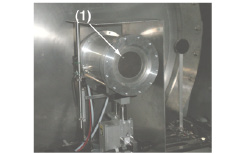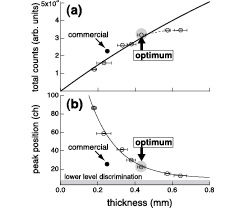A High-Resolution Detector Installed on a Focusing Small-Angle Neutron Scattering Spectrometer (SANS-U)
Shibayama Group
The small-angle neutron scattering (SANS) spectrometer SANS-U, owned by ISSP, is installed on the C1-2 cold neutron beamline of the research reactor (JRR-3) at the Japan Atomic Energy Agency (JAEA), Tokai, Japan. Recently, SANS-U was upgraded from a pinhole SANS (PSANS) spectrometer to a focusing SANS (FSANS) spectrometer by installation of a stack of 55 MgF2 lenses and a high-resolution position-sensitive detector (HR-PSD)[1]. Through this upgrade, the accessible low Q-limit (Qmin) was expanded to the order of 10-4 Å-1, where Q is the magnitude of the scattering vector, defined by Q = (4π/λ) sinθ (where λ and 2θ are the wavelength and the scattering angle, respectively). Observation of a scattering profile in this Q-range by means of an FSANS requires a longer measurement time longer than that of conventional PSANS. Consequently, measurement time for FSANS experiments usually has a higher proportion of total user machine time. Therefore, it is desirable to improve the experimental efficiency of FSANS measurements. In case of cold neutrons, ZnS/6LiF scintillation detectors are known for lower detection efficiency compared with the conventional 3He detectors. Therefore, to improve the HR-PSD, we attempted to increase the detection efficiency of the ZnS/6LiF scintillator by maintaining a high spatial resolution and a low background.

Fig. 1. Photograph of the high-resolution position sensitive detector (HR-PSD) in the flight tube of the SANS-U spectrometer. (1) The position of the fixed beam-stopper (Cd; ø4 mm). The details of the HR-PSD are described in another recent publication. [1]

Fig. 2. Scintillator thickness dependences of (a) total count, and (b) peak position on a pulse-height spectrum for the ZnS/6LiF scintillator developed by Katagiri et al. [2]
In order to increase the performance of a ZnS/6LiF scintillator for high-resolution detection of cold neutrons, we determined optimum thickness of the ZnS/6LiF scintillator. We also examined the chrematistics of the HR-PSD with the optimized scintillator, and performed FSANS measurements in order to compare the performances with a commercial scintillator. Figure 1 shows the HR-PSD installed inside the flight-tube of the SANS-U spectrometer. Note that the HR-PSD consists of a cross-wired position-sensitive photomultiplier tube (PSPMT) combined with a ZnS/6LiF scintillator. According to the specifications of the PSPMT, the size of the effective area of the PMT and its spatial resolution are about ø100 mm and 0.45 mm, respectively. The HR-PSD packed in an Al vessel was mounted on an X-Z movable bench in front of the main 3He-PSD. Figure 2(a) shows the total count of neutrons depending on scintillator thickness. By increasing the thickness from 0.180 to 0.433 mm, the total count increased remarkably from 1.23 × 105 to 3.18 × 105. In contrast, the total count increased slightly from 3.18 × 105 to 3.46 × 105 when the scintillator thickness increased from 0.433 to 0.640 mm. Figure 2(b) shows the peak position of the pulse height spectra for varying scintillator thicknesses The peak position for a commercial scintillator was estimated to be 25.54 ch. A low peak position generally leads to a decrease in counting stability because of difficulty in electrical discrimination, whereas higher values of peak positions are suitable for count stability. Hence, a trade-off exists between the total count and peak position. On the basis of the results of the total count and peak position for varying scintillator thickness, we determined optimum thickness. The requirements for the HR-PSD were as follows: (i) high detection efficiency and (ii) peak position approximately equal to that of the commercial scintillator. Accordingly, the optimum scintillator thickness was determined to be 0.433 mm. The beam intensities obtained using the optimum ZnS/6LiF scintillator were 1.39 times higher than those obtained using the commercial scintillator, which is consistent with the results of pulsed height measurements for comparison.
In conclusion, the total count of direct focused beam intensity was 1.39 times that of the commercial scintillator while maintaining both Q-resolution and the background count at the same level. This optimization resulted in a significant improvement in the experimental efficiency of the FSANS experiments.[3]
References
- [1] H. Iwase, H. Endo, M. Katagiri, and M. Shibayama, M. J. Appl. Cryst. 44, 558 (2011).
- [2] M. Katagiri, K. Sakasai, M. Matsubayashi, T. Nakamura, Y. Kondo, Y. Chujo, H. Nanto, and T. Kojima, Nucl. Instrum. Methods A 529, 274 (2004).
- [3] H. Iwase, M. Katagiri, and M. Shibayama, M. J. Appl. Cryst. 45, 507 (2012).
